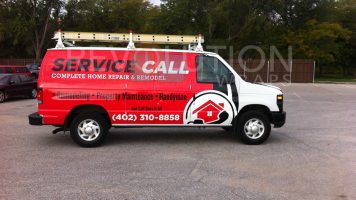Backlit Options for Graphics | Sign & Digital Graphics.
Backlit Options for Graphics
By: Dave King
Wednesday, February 1, 2012
Choices for illuminating your graphic that will make more money
In our industry, the term backlit is a generic description for any graphic that is lit from behind. But the best backlit solution for your specific application will be determined by the products you use to create it. To better understand today’s backlit display options, it’s good to have a little background on its evolution.
Historically, the most successful and perfect color for backlits have been made using Duratrans material. Backlits with this product were made using photographic processes and a darkroom; and later using a laser-based photographic image setter such as the Durst Lambda or the Océ LightJet imager. Duratrans is made of polyester and is coated with an emulsion that, when exposed to a photographic light source, could then be processed with a developer.

Adhesive-backed vinyl can be a good choice for backlit retail displays such as this holiday window display.
The result was a 4,000 dpi backlit that was designed for indoor use only because it would fade fast in direct sunlight. Later, inkjet print shops tried to duplicate the Duratrans backlit by reverse-printing onto polyesters using aqueous-based printers (Encad, Epson, etc.). These were not as good as Duratrans but the entry cost to produce these prints was less than $40,000 vs. a full-on photo imager solution at close to $250,000. Still, none of these solutions were outdoor durable. That is, until outdoor durable inks came along.
Taking it Outdoors
Outdoor inks are durable and resist fading, but graphics printed with solvent inks tend to be more opaque and less vibrant in color than traditional indoor inks; and the more solid inks like UV-curable and latex inks tend to produce graphics that are solid in color but not as bright for backlits when using the same level of back lighting.
The reason is that the solid inks restrict the light passing through the ink, so typically a stronger light source is best for these types of inks. (Please keep in mind that the above statement is generally true, but you will find that careful color management can make a huge difference when making backlit displays.)
The goal of most outdoor backlit graphics is to create something that is equally visible during sunny days and through dark nights. Let’s look at various application options first, then we can examine the products that help make the applications.

Here a backlit display is shown at the busy Huntsville Airport. The large display was created with no seams, employs LED lighting, and a large Matrix frame for easy change-out by airport employees. (Photo courtesy of Brilliant Graphics Group)
Standard Backlit—I call a standard backlit a single layer of ink on a single layer of translucent media. These applications are great for short-term backlit applications like window displays, P.O.P. displays, concerts and airport graphics.
Typically these are the most popular of all the backlit graphics but they typically do not have the same look during the day as at night when they are lit from behind. Typical materials used here are backlit banner, adhesive backed translucent vinyl, paper, polyester, fabric, etc.
Double-Strike Backlit—In order to gain greater color density on a backlit, you can double-strike the media with two layers of ink when printing. This process is best done when the application will be seen only when backlit, such as for concert graphics and indoor backlit boxes. The reason I say “only” when backlit is because a double-struck image will appear too dark when not illuminated from behind. The printing speed for doing a double strike tends to be very slow, and depending on your printer, can be prone to drying and/or cracking.

This interior backlit is set in a board room and employs a Matrix frame. (Photo courtesy of Brilliant Graphics Group)
Day/Night Backlit—This type of backlit has been around for a long time, but most people are not familiar with this product. A true day/night product looks the same during the day as it does when lit from behind at night. It is best for long-term outdoor signs, and where image quality is important to the client.
To make a day/night backlit you need to layer two adhesive-backed vinyl images on top of each other. For a full-color sign you would first start with a clear sheet of UV Lexan or UV acrylic. Mirror print the image onto a clear vinyl, then mirror-print the same image onto a translucent vinyl. Next, apply the clear to the inside of the Lexan/acrylic (so the UV coating on the Lexan/acrylic is facing out), then apply the translucent image to the back of the clear image (alignment is crucial here). Finish by coating with a UV laminate to protect the image from the bulbs in the light box. Now you have a 24-hour perfect outdoor day/night backlit.
Backlit Material Choices
Now that you know the basic types of backlit applications, let’s look at some of the products that are used to make backlits.
Backlit Paper—Paper designed for backlit applications is readily available and comes in all different sizes and thicknesses. It is very popular for doing bus shelters, mall displays and other short-term backlit displays. It is a low-cost media option that has become very popular for backlits.
I have found that many backlit papers do not produce great-looking displays when using solvent inks; and many of the paper companies do not produce a “true white” backlit paper, so displays can appear a little yellow. At around 11 cents a square foot, it’s hard to argue, but in this case you do get what you paid for.

The choices are significant for doing backlits—not only the choices for building the backlit, but the materials you use to make them.
Litho-Printable Polyester/Mylar—This is a great product for making really durable backlits using UV-curable ink. The film comes in thicknesses up to 10 mils, is coated for the ink, and available in a roll size of 54″ x 150′. Backlit prints created with this material using UV-cure inks are very durable and the ink sticks so well that almost nothing takes it off.
The product is available in clear and translucent versions, and works great in any high-use areas such as rolling displays in malls, theater backdrops, roll-up displays, quick change-out backlit displays (such as snap frames), and more.
A reasonable cost for this product makes this a winner for UV-curing printers. This product comes in at around 50 cents a square foot, is available in 10 mil thickness, and is a very good choice for a very durable display.
Printable Film—There are so many different printable films today, and a number of them can be used for backlit applications. However, each will produce different results. For example, 20-mil polystyrene, polyester, polyethylene, PVC and melamine can be employed, each with different results. Look for printable films that are designed for backlit applications.
Backlit Banner—Banner material can be used for backlit applications, but not regular scrim banner. The nylon scrim weave through the center of the banner material will look bad when you shine light through it—like the image was printed on graph paper.
Manufactures came up with a special way to produce a weave so it is almost invisible when backlit. They reduced the weave down to a very thin thread, and put them closer together making the backlit work while retaining the strength of scrim.
I see more and more backlit banners used in airports where they want a large low-cost display with no seams. Many music concerts are staged using this type of backlit banner. Cost for backlit banner is around 40 cents a square foot.

Certain banner materials, with special scrim weave, work great for very large outdoor backlits. (Photo courtesy of Artcraft Design).
Fabric Backlit—More and more fabrics are being used as backlit displays these days. A company called Matrix has perfected backlit fabric displays in sizes that are almost endless. More and more companies are moving to fabrics for backlits because they are light weight, easy to install, and produce stunning vibrant colors when printed using a dye-sub process.
Today the issue for many retailers and companies that are selling space is the cost of doing a change-out—hiring installers and working around the business schedule is difficult and costly.
When you introduce systems that enable maintenance people of a company to change out the graphics, you have significantly increased the value of the graphic solution. The cost of dye-sub fabric is around 30 cents a square foot, but does require a significant investment in equipment to make and finish the prints.
Adhesive-Backed Vinyl Backlit Film—The choices here are huge, but generally the products are clear and translucent calendared films with either a removable or a permanent adhesive. I almost never use a permanent adhesive for my backlits as I find the removable last for years, and I’ve never had an issue with sticking. All the major vinyl film manufactures offer backlit adhesive-backed films, and some offer versions that employ air-release technology for easier installation.
Try to keep matched vinyls together. For example, if you are doing day/night displays with two layers of vinyl, you should not mix vinyl from different manufactures as you might run into a shrinkage issue where the two films do not shrink at the same rate.
One warning here: You should only purchase high quality vinyl that is made with a quality plasticizer because it is less prone to cracking and/or shrinking. The cost to replace a graphic will be much more than the few extra bucks you paid for good quality material. Typical cost for this type of vinyl is about 60 cents a square foot.
So Many Choices
The choices are significant for doing backlits. Consider your options carefully and you will enjoy what can be a profitable niche. I have done very well over the years making backlits, and I will say that these products are typically never in the commodity price market—meaning I get between $12 and $20 a square foot for just the print, plus installation. At the end of the day I make a good day’s pay for creating a fantastic backlit.
Be careful out there. Remember, no matter what type of backlit displays you offer, be sure to build them so they adequately meet the needs of your customer. If a backlit fails, your exposure is huge and replacement cost can be significant. Meantime, good luck, and be smart with your money. I’ll see you on the show floor.


